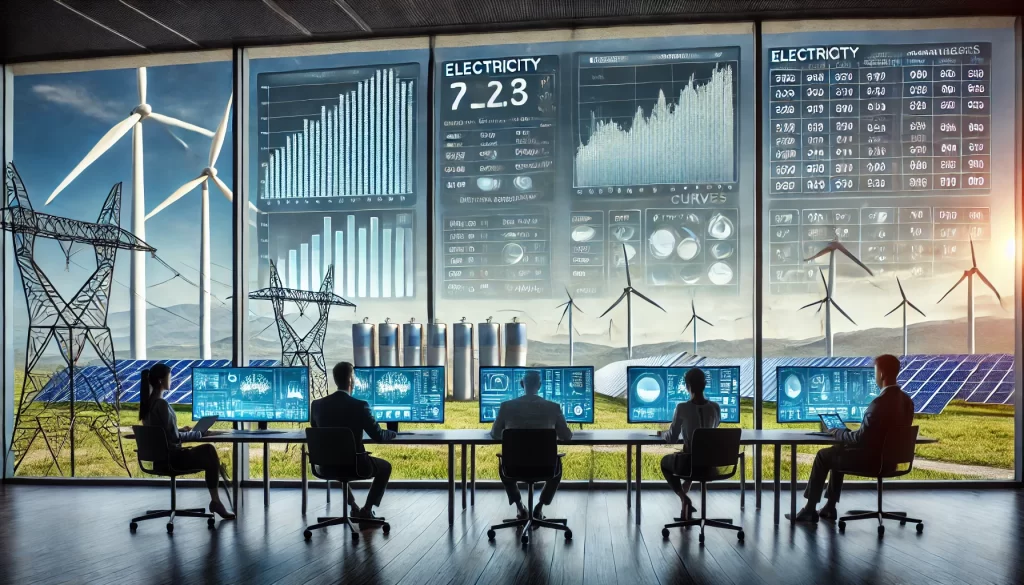Revolutionizing Renewable Trading: A Leap to Real-Time Markets

Client Position:
Our client, an energy trading firm, was unprepared for the trading of battery power on a brand new electricity exchange designed for near real time trading. With outdated technology and manual processes, they risked not being a player in the energy transition and renewable markets
This case study shows how we helped them with energy transition, ensuring profitability, and sustained competitive advantage
Contextual Overview of the Renewable Electricity Market
Before diving into the specifics, it’s useful to understand the broader context of recent electricity sector developments:
- Improved Solar and Wind Generation: Significant advancements have been made in renewable technologies, however, these sources are often weather dependant, which can result in wasted electricity during periods of low demand and not enough during peak demand.
- Battery Storage Advancements: Grid-scale batteries, or ‘mega batteries,’ have been a game changer, these can now store electricity during low demand periods and discharge it during peak demand. These mega batteries are often co-located with renewable generation sources in remote areas, so the development of mobile, truck sized batteries is yet another game changer, it means that the battery can move and be discharged closer to high population areas where it is needed.
- Market Dynamics and Return on Investment: As with all markets, if there is high demand and limited supply, the price goes up. Mega batteries are perfectly place to meet these peak demands, in the UK this market is referred to as the Fast Response (FR) market which will operate on a new, near real time trading exchange. For those that have invested substantial capital to build these mega batteries, they expect their trading agent, usually the operating agent too, to optimise trades, achieve the best price and good returns on their investment. Failure to achieve optimal trading returns can lead to investors switching to more competent trading and operating firm.
Understanding this market highlights the critical role of our client, the trading and operating agent in ensuring profitability in the evolving energy markets.
Understanding the Problem
Our client, a leading player in the energy sector, was confronted with a significant challenge as the electricity trading landscape rapidly evolved. Advances in renewables, battery storage, and IT introduced real-time electricity markets, demanding swift adaptation. With less than three months until the launch of a new fast response electricity exchange, the client found themselves unprepared. Their outdated technology and manual trading processes were insufficient to keep up with changing market prices, monitor available electricity and its location, and optimize trades accordingly.

Furthermore, they did not meet the new exchange’s technology and API requirements to submit bulk trades. Failing to optimize trades for maximum profit or submit bulk trades risked damaging their reputation, potentially resulting in being replaced by the battery owners and losing future contracts as an operating and trading agent.
Our Approach
To address these urgent needs and ensure a seamless transition to the new trading environment, we implemented a comprehensive strategy:
- Project Governance:
- Established a robust governance framework, including a Project Board and Stakeholder Group to oversee progress and decision-making.
- Stakeholder Engagement:
- Produced a RACI matrix identifying key internal and external stakeholders.
- Facilitated regular communication through managed engagement channels.
- Market Analysis and Requirements Documentation:
- Gained an in-depth understanding of the renewable and battery market.
- Documented detailed requirements through User Stories and Use Cases.
- Created a BRD lite to capture essential business requirements.
- Process Mapping:
- Mapped ‘As Is’ and ‘To Be’ process flows to develop a new Target Operating Model.
- Project Planning and Agile Management:
- Developed a comprehensive project plan outlining key activities.
- Generated a backlog of epics, stories, and tasks on the agile workboard.
- Facilitated daily scrums for project alignment and progress.
- Technical Development and Team Management:
- Managed a team of developers to configure systems and build APIs.
- Produced a minimum viable product (MVP) to ensure our client could trade from day one of the new exchange.

Future Roadmap:
- Engaged with our client’s commercial team and the battery asset team employed by the private equity firm that financed the batteries, securing their acceptance of the MVP and buy-in for the roadmap.
- Developed a roadmap to achieve full trade optimization and capability, ensuring long-term success.
Outcomes and Impacts
Through strategic planning, diligent effort, and effective stakeholder engagement, our client successfully transitioned to the fast response electricity market exchange. The implementation of the MVP allowed for immediate trading capabilities, while the comprehensive roadmap laid the foundation for future enhancements and full trading optimization. This transformation ensured compliance with the new exchange rules and positioned our client as a leading operator and trader in the evolving energy markets. Consequently, they are now well-positioned to secure contracts from other renewable energy and battery owners, enhancing their competitive advantage in the post-energy transition landscape.
Conclusion
This case study demonstrates our expertise in guiding energy trading companies through technological and operational transitions. Our hands-on approach, in-depth industry knowledge, and agile project management ensure that our clients are well-prepared to meet emerging challenges and seize new market opportunities. Our success with our client underscores our capability to deliver impactful solutions that drive business growth and innovation.
